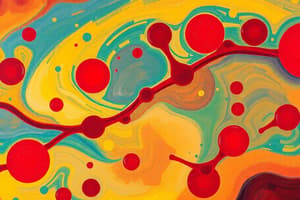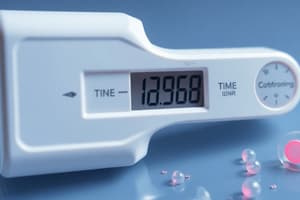Podcast
Questions and Answers
What is the primary role of thrombocytes in the blood clotting process?
What is the primary role of thrombocytes in the blood clotting process?
- Converting fibrinogen into fibrin to create the mesh-like structure of a clot.
- Secreting von Willebrand factor to attract other clotting factors.
- Gathering at the site of blood vessel damage and adhering to the wounded tissue. (correct)
- Initiating the coagulation cascade by activating specific clotting factors.
How does a deficiency in vitamin K potentially lead to a longer PT test result?
How does a deficiency in vitamin K potentially lead to a longer PT test result?
- Vitamin K promotes the initial constriction of blood vessels at the injury site.
- Vitamin K is essential for the liver to produce prothrombin, a clotting factor. (correct)
- Vitamin K is directly involved in the conversion of fibrinogen to fibrin.
- Vitamin K assists in the production of thrombocytes.
What is the role of von Willebrand factor in the process of normal thrombus formation?
What is the role of von Willebrand factor in the process of normal thrombus formation?
- It facilitates platelet adhesion to the damaged blood vessel wall. (correct)
- It causes the smooth muscles of damaged blood vessels to spasm.
- It converts fibrinogen into fibrin strands to create the mesh-like structure of a clot.
- It initiates the coagulation cascade by activating clotting factors.
Which component of blood is primarily responsible for transporting clotting factors and other proteins involved in coagulation?
Which component of blood is primarily responsible for transporting clotting factors and other proteins involved in coagulation?
Cirrhosis of the liver can prolong PT test results because the liver is responsible for what aspect of blood clotting?
Cirrhosis of the liver can prolong PT test results because the liver is responsible for what aspect of blood clotting?
During the formation of a blood clot, what process directly leads to the creation of a mesh-like structure that traps blood cells?
During the formation of a blood clot, what process directly leads to the creation of a mesh-like structure that traps blood cells?
Following a skin injury, the initial response of blood vessels to reduce blood loss involves:
Following a skin injury, the initial response of blood vessels to reduce blood loss involves:
Why is the International Normalized Ratio (INR) used in conjunction with prothrombin time (PT) testing?
Why is the International Normalized Ratio (INR) used in conjunction with prothrombin time (PT) testing?
A patient has an INR of 1.5. What does this result suggest in the context of blood coagulation?
A patient has an INR of 1.5. What does this result suggest in the context of blood coagulation?
How does aspirin affect prothrombin time (PT) and why is this effect sometimes medically desirable?
How does aspirin affect prothrombin time (PT) and why is this effect sometimes medically desirable?
In the context of hemostasis, what is the primary role of prothrombin?
In the context of hemostasis, what is the primary role of prothrombin?
If a patient's blood does not clot within the normal prothrombin time range, what might this indicate?
If a patient's blood does not clot within the normal prothrombin time range, what might this indicate?
What is the relationship between thrombus formation and hemostasis?
What is the relationship between thrombus formation and hemostasis?
A patient requires regular monitoring of their prothrombin time (PT)/INR. What condition or medication are they most likely being treated for?
A patient requires regular monitoring of their prothrombin time (PT)/INR. What condition or medication are they most likely being treated for?
How does the prothrombin time (PT) test contribute to assessing the risk of cardiovascular events such as heart attack or stroke?
How does the prothrombin time (PT) test contribute to assessing the risk of cardiovascular events such as heart attack or stroke?
Flashcards
Formed elements
Formed elements
Living components of blood: red blood cells (erythrocytes), white blood cells (leukocytes), and platelets (thrombocytes).
Plasma
Plasma
The fluid portion of blood, consisting of water, proteins, and electrolytes.
Thrombocytes (Platelets)
Thrombocytes (Platelets)
Cells in the blood responsible for forming blood clots.
Vascular spasm
Vascular spasm
Signup and view all the flashcards
von Willebrand factor
von Willebrand factor
Signup and view all the flashcards
Coagulation cascade
Coagulation cascade
Signup and view all the flashcards
Fibrinogen
Fibrinogen
Signup and view all the flashcards
Thrombus
Thrombus
Signup and view all the flashcards
Hemostat
Hemostat
Signup and view all the flashcards
Prothrombin Time (PT)
Prothrombin Time (PT)
Signup and view all the flashcards
Blood Clot Function
Blood Clot Function
Signup and view all the flashcards
International Normalized Ratio (INR)
International Normalized Ratio (INR)
Signup and view all the flashcards
Normal INR Range
Normal INR Range
Signup and view all the flashcards
Effect of Blood Thinners
Effect of Blood Thinners
Signup and view all the flashcards
Risks of Untreated Clots
Risks of Untreated Clots
Signup and view all the flashcards
Study Notes
- Hemostats are surgical forceps used to clamp blood vessels, with the term 'hemostat' meaning to stop bleeding.
- The body's natural hemostatic ability forms blood clots, also known as coagulation or thrombus.
Prothrombin Time Defined
- Prothrombin time (PT) measures the time it takes for blood to produce a thrombus or blood clot.
- Blood clots close exposed vessels by forming a scab, preventing excessive bleeding from cuts and scrapes.
- A prothrombin time test assesses whether blood clots at a normal rate
Normal Prothrombin Time
- A prothrombin time test may take the form of either a finger prick or a blood draw.
- Labs can use a variety of tests to calculate a patient's prothrombin time, each with its own scale of what a normal range is.
- The International Normalized Ratio (INR) provides a universal normalized prothrombin range to account for any influence that different PT tests may have on the test results.
- The normalized INR range allows values between laboratories to be readily compared without concern for accounting for their different testing methods.
- Most labs report using the INR format, which dictates a normal range of 0.8 to 1.1, translating to 11 to 13 seconds.
- It should take 11 to 13 seconds for a drop of a healthy person's blood to coagulate.
- Blood thinners, such as aspirin, can lengthen prothrombin time.
- People at risk for heart attack or stroke may take aspirin to thin their blood and prevent clot formation.
- Clots formed and released into the bloodstream can cause blockages, leading to heart attack or stroke.
- A longer-than-normal PT test could indicate a vitamin K deficiency.
- Vitamin K is required by the liver to produce prothrombin, one of the five clotting proteins evaluated by a PT test.
- A longer PT test could indicate cirrhosis of the liver, or liver disease since the liver produces each of the five clotting factors.
Blood Composition
- Blood consists of formed elements (living components) and plasma (non-living component).
- Formed elements include:
- Erythrocytes (red blood cells)
- Leukocytes (white blood cells)
- Thrombocytes (platelets).
- Plasma is the fluid in which blood cells float, consisting of water, proteins, and electrolytes.
- Platelets are called thrombocytes because their primary function is to form blood clots ('thrombo').
Normal Thrombus Formation
- When a blood vessel is damaged:
- Smooth muscles spasm to constrict blood flow to the area.
- Platelets gather in the damaged area.
- Damaged skin cells secrete von Willebrand factor, causing platelets to stick to the wound.
- The blood undergoes a coagulation cascade, where clotting factors interact to convert fibrinogen into fibrin.
- Fibrin forms chains and collects around platelets, forming a mesh-like structure that traps blood cells and completes clot formation.
Studying That Suits You
Use AI to generate personalized quizzes and flashcards to suit your learning preferences.




